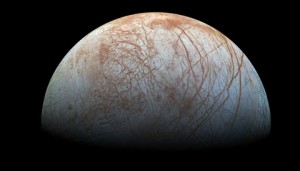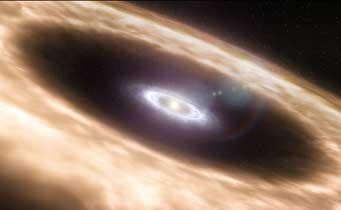Scientists propose that Saturn’s meddling helped create the four giant Galilean moons orbiting Jupiter.

NASA / JPL / SETI Institute
Jupiter, with its 67 known moons, can be viewed as a miniature solar system revolving around the Sun. Four of these moons are large enough to be visible with even a small telescope. These so-called Galilean satellites — Io, Europe, Ganymede, and Callisto — are of nearly planetary size.
But scientists haven’t been able to explain how these moons became so big. Now, scientists have conducted a study to suggest that Saturn might be to blame.
During the solar system’s earliest years, a huge rotating disk of gas and dust surrounded the Sun. The dust quickly glommed together into pebble-sized chunks, out of which the planets and most moons formed. As Jupiter came together, it acquired its own disk by sweeping clean a gap in the gaseous disk around the Sun. It’s likely that the Galilean moons began forming within Jupiter’s circumplanetary disk.But even as the giant collected gas from the circumsolar disk, it was carving the gap that would cut off its disk from material that would have helped build its moons.
René Heller (University of Göttingen, Germany), who was not involved in the new study, notes that astronomers have long been lacking a mechanism to deliver solid material to Jupiter’s circumplanetary disk. "This aspect has often been overlooked or simplified in previous models for the formation of the Galilean satellites; we assumed that the gas and dust was just there, out of nowhere," he says.
One of the astronomers who investigated this impasse is Thomas Ronnet (Astrophysical Laboratory of Marseille,France). He realized that Jupiter’s massive neighbor Saturn might be involved. When the planets were forming, their orbits were still migrating — resulting in a solar system that looked very different from the one we see now, Saturn in particular is thought to have been in an orbit much closer to that of Jupiter. So Saturn could have dispersed pebbles that were stuck in the midplane of the circumsolar disk, allowing Jupiter to capture them.
Simulating a Solution

ESO
Ronnet recalls struggling to develop this theory. "I knew it might work, but I wasn’t sure," he says. To test it, Ronnet and colleagues ran computer simulations, following the trajectories of 5,000 planetesimals, as well as Jupiter and Saturn, in the early solar system.To save computing time they eliminated each planetesimal that came close enough to Jupiter to be trapped in its gravitational sphere of influence. They also computed which planetesimals would pass by Jupiter, reaching the asteroid belt.
Initially, the researchers worried that the asteroid belt would spoil the Saturn hypothesis. "It was a welcome surprise to find that fewer planetesimals became implanted in the asteroid belt than in Jupiter’s circumplanetary disk," says Ronnet. The results appear in the May 3rd Astronomical Journal.
"Their research proposes a fascinating scenario which from the presented results seems to work quite well," says Giacomo Lari (University of Pisa, Italy), who was not involved in the study.
The Galilean moons could have subsurface oceans, which might make them the next best place in the solar system for life, and that could be the case in other planetary systems as well. But the new study suggests that particular circumstances are required to create worlds like these: “Our study suggest that analogs to the Galilean moons would preferentially form around giant planets within multiple planetary systems,” Ronnet says.
 2
2









Comments
Tommy-Howe
June 10, 2018 at 8:09 pm
Genesis explains it ALL in plain English, but it seems that all of these highly educated scientists can't read!
You must be logged in to post a comment.
Jacques Millet
June 14, 2018 at 11:48 am
Could anyone explain to me how dust "glom" to form pebbles? Electrostatic? Heat? Gravity?? Are stars formed first by pebbles? As far as I know, gravity is what makes gas and dust to accumulate into stars and probably also planets and large satellites. Asteroids and meteors are probably the result of collisions between planetoids. How could you explain meteors made of solid iron? By iron dust agglomerating into pebbles?
You must be logged in to post a comment.
You must be logged in to post a comment.